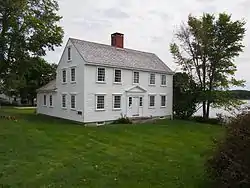 | |
| Established | 1921 |
|---|---|
| Location | 107 Perkins Street Castine, Maine |
| Coordinates | 44°23′02″N 68°48′22″W / 44.3840°N 68.8060°W |
| Type | Natural history, history |
| Website | www |
The Wilson Museum is a museum in Castine, Maine, United States. It was founded using the collection of Dr John Howard Wilson, a geologist.
History
Wilson lived in Philadelphia, Brooklyn and Nantucket during his youth. He arrived at Castine in 1891 with his mother, Cassine Cartwright Wilson. He received a PhD in geology from Columbia University.
In 1921, Mrs Wilson gave the western part of the land she owned to build a museum for John Wilson's collections. The building was designed by architects Milton See & Son of New York.[1] Three other buildings were added in the late 1960s, the Blacksmith Shop, Hearse House, and the John Perkins House.
Collections
- Rocks, minerals, shells.
- Pre-historic artifacts from North and South America.
- Exhibits from Europe and Africa illustrating the development of tools during the early Paleolithic, Neolithic, Bronze and Iron Ages.
- Six dioramas constructed by Ned Burns of the American Museum of Natural History in 1926.
- Cultures of Africa, Oceania, North and South America.
- Early weapons and firearms.
- Local history.
- Ship models.
- 19th century carpenter's tools, farm and household equipment.
- Special exhibits every summer using the museum's collections.
- Archival material on the history of Castine.
References
- ↑ Handbook of American Museums. 1932.
External links
This article is issued from Wikipedia. The text is licensed under Creative Commons - Attribution - Sharealike. Additional terms may apply for the media files.